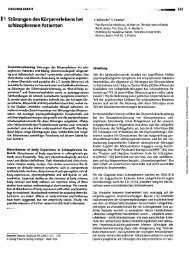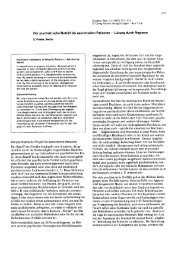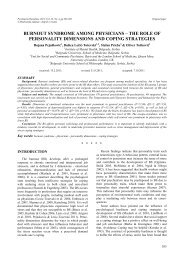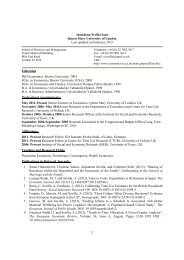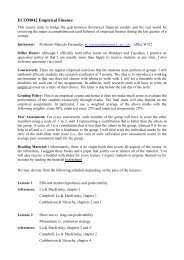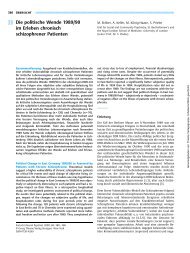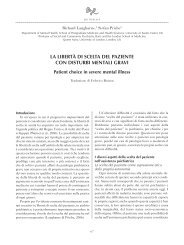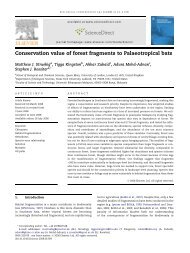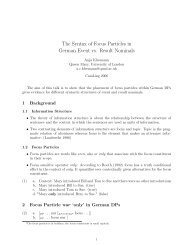Proofs - Personal Webspace for QMUL - Queen Mary, University of ...
Proofs - Personal Webspace for QMUL - Queen Mary, University of ...
Proofs - Personal Webspace for QMUL - Queen Mary, University of ...
You also want an ePaper? Increase the reach of your titles
YUMPU automatically turns print PDFs into web optimized ePapers that Google loves.
cross- cultural mental health training and further research<br />
on evaluation will be discussed. The need <strong>for</strong> the development<br />
<strong>of</strong> cross- cultural training will be exemplifi ed from German<br />
and Swedish experiences. Development is necessary as both<br />
Germany and Sweden have a high proportion <strong>of</strong> migrants and<br />
refugees, and a scanty history <strong>of</strong> institutionalized support <strong>for</strong><br />
cross- cultural mental health training. Both countries face the<br />
urgent challenge to adapt mental health care to the increasingly<br />
more cultural diverse population in combination with<br />
some <strong>for</strong>m <strong>of</strong> social and political acceptance <strong>for</strong> adaption <strong>of</strong><br />
mental health care delivery.<br />
2. Cultural diversity and mental health care<br />
in Sweden and Germany<br />
In the EU- 27 states there are currently 47.3 million <strong>for</strong>eignborn<br />
residents, corresponding to 9.4% <strong>of</strong> the total population [16],<br />
1.6 million recognised refugees and about 514,000 stateless<br />
people living in the EU- 27 [47]. In Sweden, immigration consists<br />
to a great extent <strong>of</strong> refugee immigration and family reunions.<br />
First and second generation migrants in Sweden constitute<br />
18.6% [40] <strong>of</strong> the population. The main country <strong>of</strong> origin is<br />
Finland (172,218 persons), followed by Iraq (117,919 persons)<br />
and <strong>for</strong>mer Yugoslavia/ Serbia Montenegro (71,578 persons).<br />
The total population is 9.3 million [40].<br />
Germany currently has 16 million people with a so- called<br />
migration background. These are <strong>for</strong>eign- born residents and<br />
their <strong>of</strong>fspring, which is an equivalent <strong>of</strong> 19% <strong>of</strong> the general<br />
population <strong>of</strong> 82 million [41]. Germany is the industrialized<br />
nation with the largest refugee population (594,000) [18]. The<br />
largest migration groups are comprised <strong>of</strong> people with their roots<br />
in Turkey (3.0 million), in the succession states <strong>of</strong> the <strong>for</strong>mer<br />
Soviet Union (2.9 million) and in the succession states <strong>of</strong> the<br />
<strong>for</strong>mer Yugoslavia (1.5) [41].<br />
Sweden and Germany have made various attempts to adapt<br />
the mental health care system to the needs <strong>of</strong> patients with a<br />
migration and cultural minority background. In Sweden, clinics<br />
<strong>for</strong> treating victims <strong>of</strong> trauma were established in the 1980s. The<br />
use <strong>of</strong> interpreters is free <strong>of</strong> charge and separately fi nanced. Over<br />
the years there have been several local time- limited projects on<br />
improving care <strong>for</strong> refugees and migrants [3].<br />
In 1999 the Transcultural Centre was established by<br />
Stockholm County Council, the regional government responsible<br />
<strong>for</strong> care in the area <strong>of</strong> Greater Stockholm. Today the Transcultural<br />
Centre <strong>of</strong>fers support and training to health pr<strong>of</strong>essionals in<br />
hospitals and local health care units in psychiatric care, somatic<br />
care and dental care in the Stockholm area. The Centre also provides<br />
supervision, networking, and in<strong>for</strong>mation regarding issues<br />
related to culture, migration and asylum and refugee status [3].<br />
Until recently very little has been done to educate immigrants<br />
and refugees about the possibilities <strong>of</strong>, and routes to, the<br />
(mental) health care system. In the past few years projects with<br />
health communicators have been established in some counties<br />
in Sweden. The health communicators in<strong>for</strong>m newcomers about<br />
health care and health- related issues [4].<br />
In Germany, psychological counselling services were the<br />
fi rst institutions in the 1970s <strong>of</strong>fering specialised services <strong>for</strong><br />
S. Bäärnhielm et al. / European Psychiatry 27 (2012) / supplement n°2 / S70-S75 S71<br />
migrants. Since then a movement called “intercultural opening”<br />
(“Interkulturelle Öffnung”) has tried to focus more on the<br />
needs <strong>of</strong> patients with a migration background [20]. More and<br />
more bilingual in- and outpatient treatment programs have<br />
been implemented. Currently more than two dozen institutions<br />
<strong>of</strong>fer such a bilingual psychotherapeutic treatment<br />
program [33]. A major impact was a health political movement<br />
to improve the psychiatric, psychotherapeutic as well<br />
as the general practitioners’ health care service <strong>for</strong> migrants<br />
resulting in the “12 Sonnenberger Guidelines” [29]. These<br />
addressed issues <strong>of</strong> easier access to psychosocial health care<br />
institutions, cross- cultural sensitive and competent staff with<br />
heterogeneous cultural background, organisation and usage <strong>of</strong><br />
psychological trained interpreters, provision <strong>of</strong> in<strong>for</strong>mation<br />
material in different languages as well as specifi c (further)<br />
education opportunities.<br />
3. Cross- cultural training<br />
3.1. Conceptualisation <strong>of</strong> cross- cultural training<br />
Conceptualisation <strong>of</strong> training to improve pr<strong>of</strong>essionals’<br />
capacity to work with culturally different patients has <strong>of</strong>ten,<br />
especially in the USA, been in terms <strong>of</strong> cultural competence<br />
training [37]. Qureshi et al [37] point to that cultural competence<br />
represent an approach in the provision <strong>of</strong> mental<br />
health service and that is not a unitary concept, but rather<br />
a generic term that has no fi xed defi nition. This is apparent<br />
given the vast amount <strong>of</strong> defi nitions as well as models <strong>of</strong><br />
cross- cultural competence [12,14]. The National Centre <strong>for</strong><br />
Cultural Competence in the USA defi ne cultural competence<br />
as a developmental process that evolves over an extended<br />
period where both individuals and organisations are at various<br />
levels <strong>of</strong> awareness, knowledge and skills along the cultural<br />
competence continuum [34].<br />
In general, cultural competence training aims to increase<br />
cultural awareness, knowledge and skills <strong>of</strong> the staff and to<br />
modify their sensitivity and behaviour as well as to improve<br />
patient- staff interaction. It is seen as an instrument to improve<br />
communication between health- care providers and patients.<br />
Tseng [46] adds the aspect <strong>of</strong> cultural appropriate attitudes and<br />
empathy. Cross- cultural competence is seen as an on- going,<br />
active and nonlinear process [43].<br />
How competence training has been carried out varies.<br />
It has a broad spectrum <strong>of</strong> approaches with regard to target<br />
group, duration, content and method. Published cultural<br />
competency training programmes have been developed<br />
<strong>for</strong> different health care groups, e.g. medical students [25],<br />
nurses [12], physicians [30], mental health counsellors [48],<br />
geriatric care settings [51] and mixed groups <strong>of</strong> mental health<br />
care providers [49]. Training can vary from 4 hours [48] to<br />
10 weeks full- time [19] and the contents in general health<br />
care settings range from language training, specifi c cultural<br />
content, general concepts <strong>of</strong> culture to patient- provider<br />
interaction [36]. Little content has been published specifi cally<br />
regarding cultural competence training in mental health care<br />
settings [9].<br />
<strong>Pro<strong>of</strong>s</strong>




